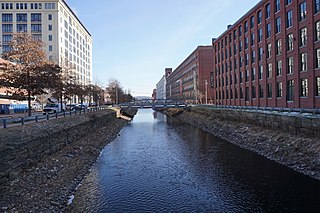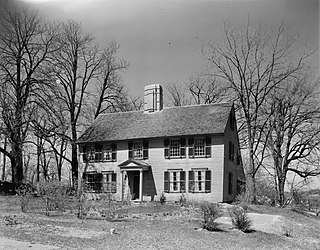
Essex County is a county in the northeastern part of the U.S. state of Massachusetts. At the 2020 census, the total population was 809,829, making it the third-most populous county in the state, and the eightieth-most populous in the country. It is part of the Greater Boston area. The largest city in Essex County is Lynn. The county was named after the English county of Essex. It has two traditional county seats: Salem and Lawrence. Prior to the dissolution of the county government in 1999, Salem had jurisdiction over the Southern Essex District, and Lawrence had jurisdiction over the Northern Essex District, but currently these cities do not function as seats of government. However, the county and the districts remain as administrative regions recognized by various governmental agencies, which gathered vital statistics or disposed of judicial case loads under these geographic subdivisions, and are required to keep the records based on them. The county has been designated the Essex National Heritage Area by the National Park Service.

Haverhill is a city in Essex County, Massachusetts, United States. Haverhill is located 35 miles north of Boston on the New Hampshire border and about 17 miles from the Atlantic Ocean. The population was 67,787 at the 2020 United States Census.

Lawrence is a smaller sized city of just under 7 square miles located in Essex County, Massachusetts, United States, on the Merrimack River. At the 2020 census, the city had a population of 89,143. Surrounding communities include Methuen to the north, Andover to the southwest, and North Andover to the east. Lawrence and Salem were the county seats of Essex County, until the Commonwealth abolished county government in 1999. Lawrence is part of the Merrimack Valley.

Andover station is an MBTA Commuter Rail station in Andover, Massachusetts. It serves the Haverhill Line. The station has one platform with a mini-high platform for handicapped accessibility serving one track, while the second track lacks a platform. The previous station building, used from 1907 to 1959, is still extant; it was added to the National Register of Historic Places in 1982 as Third Railroad Station.

Andover Town Hall is the historic town hall of Andover, Massachusetts. It is located at 20 Main Street, between Park and Barnard Streets. The 2+1⁄2 story Romanesque Revival red brick building was constructed in 1858, not long after the separation of North Andover. It was designed by Boston architect Theodore Voelkers and built by local builders Abbott & Clement. The building design echoed that of the mills that dotted the town. It was listed on the National Register of Historic Places in 1982.

Arden is a historic estate at 276 N. Main Street in Andover, Massachusetts, United States. It was the home of two of Andover's most important mill owners, John Dove and William Madison Wood.

The Parson Barnard House is a historic late-First Period house at 179 Osgood Street in North Andover, Massachusetts. The 2+1⁄2-story wood-frame house was built in 1715 by Parson Thomas Barnard after his previous house burned down. The house is one of the most important First Period houses in New England, due its unique, transitional features and excellent state of preservation. For many years it was believed to be the home of colonial governor Simon Bradstreet and his wife Anne.

The Central Street District is a historic district encompassing the traditional heart of Andover, Massachusetts prior to the development in the later 19th century of the current town center. It consists mainly of residential and religious properties along Central Street, from Phillips Street in the south to Essex Street in the north. All of the listed properties have frontage on Central Street, even if their addresses are on one of the adjacent streets.

The Chandler-Hidden House is a historic house in Andover, Massachusetts. It was built for Isaac Chandler, probably by his son-in-law David Hidden, in about 1812. Hidden, a housewright, had come to Andover to help in the construction of the Andover Theological Seminary. He married Chandler's daughter in 1816, bought half the house in 1828, and the rest after Chandler's death in 1834. The house passed out of the Hidden family in 1897. It is a 2+1⁄2-story Federal style colonial, with five window bays and two side chimneys. The centered front door is protected by a protruding portico, and there is a rear ell that appears to be original to the house.

The Nathan Frye House is a historic house in Andover, Massachusetts. The large mansion was built in 1851-52 for Nathan Frye, who had recently (1849) become president of the Marland Mill Company, one of Andover's major textile firms. It features grand Italianate details, including bracketed eaves, corner quoins, and pedimented gables. The building and its associated carriage house have been extensively altered for commercial purposes in the late 20th century, but much of the architectural interest has been retained.

The Manning House is a historic house in Andover, Massachusetts. It was built c. 1760 for Hezekiah Ballard, a local farmer. Ballard sold the property to Thomas Manning, a cordwainer, in 1771, and it has been in the Manning family ever since. The main block of the house is a 2+1⁄2-story colonial structure with a gambrel roof, which is rare in Andover for the period. Its main entrance is into a projected central vestibule, and there are a series of additions added to the back of the house.

The George Kunhardt Estate, also historically named Hardtcourt, is a historic estate off Great Pond Road in North Andover, Massachusetts. Built in 1906 for George Kunhardt, a principal owner of textile mills in the Merrimack Valley, the estate later became known as Campion Hall when it served as a Jesuit retreat center. After sitting vacant for many years, the property has been converted into residential condominiums. The property was listed on the National Register of Historic Places on April 22, 1976.

The North Canal Historic District of Lawrence, Massachusetts, encompasses the historic industrial heart of the city. It is centered on the North Canal and the Great Stone Dam, which provided the waterpower for its many mill complexes. The canal was listed on the National Register of Historic Places in 1975, while the district was first listed in 1984, and then expanded slightly in 2009.

Osgood Hill – also known as the Stevens Estate at Osgood Hill– is a mansion and estate at 709–23 Osgood Street in North Andover, Massachusetts. It was listed on the National Register of Historic Places in 1999.

The James Nichols House is a historic house in Reading, Massachusetts. Built c. 1795, this 1+1⁄2-story gambrel-roofed house is built in a vernacular Georgian style, and is a rare local example of the style. The house was built by a local shoemaker and farmer who was involved in a religious dispute that divided the town. The house was listed on the National Register of Historic Places in 1984.

The Frank J. Cobbs House is a private house located at 407 E. Chapin Street in Cadillac, Michigan. It was designated a Michigan State Historic Site in 1985 and listed on the National Register of Historic Places in 1988.

George G. Adams was an American architect from Lawrence, Massachusetts.

Massachusetts House of Representatives' 4th Essex district in the United States is one of 160 legislative districts included in the lower house of the Massachusetts General Court. It covers part of Essex County. Republican Brad Hill of Ipswich represented the district from 1999 to 2021. Following Hill's appointment to the state's Gaming Commission, Democrat Jamie Belsito of Topsfield won a special election serve out the remainder of Hill's term.

Massachusetts House of Representatives' 14th Essex district in the United States is one of 160 legislative districts included in the lower house of the Massachusetts General Court. It covers part of Essex County. Democrat Christina Minicucci of North Andover has represented the district since 2019.






















